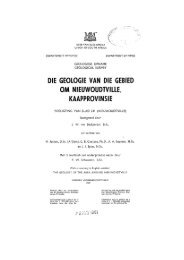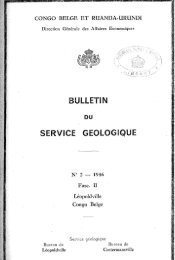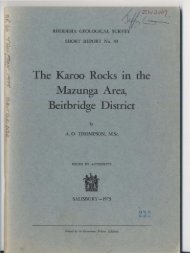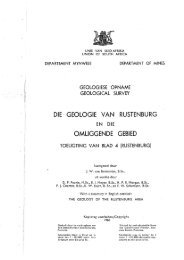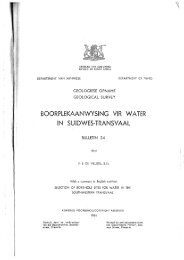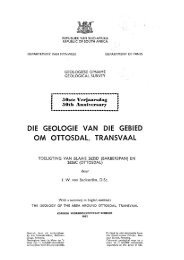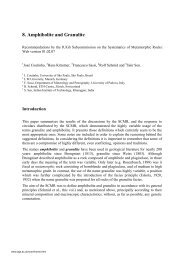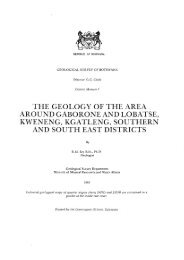Bibliography - British Geological Survey
Bibliography - British Geological Survey
Bibliography - British Geological Survey
You also want an ePaper? Increase the reach of your titles
YUMPU automatically turns print PDFs into web optimized ePapers that Google loves.
Smith, G. E. 1931a. The discovery of primitive man in China. Antiquity, 5 (Mar), no. 17, 21–36, plates I–V.<br />
(The author believes that the discovery in China of Sinanthropus, or Peking Man, provides a link between<br />
both Pithecanthropus and Eoanthropus, which were previously thought to be irreconcilable. An account is<br />
given of the circumstances of Dawson’s discovery of the first Piltdown skull fragments, including a detail<br />
not previously recorded. He thus describes how Dawson, having earlier asked the workmen at Barkham<br />
Manor to keep a watch for any fossil remains which they might find, returned to the spot in 1912 (actually,<br />
about 1908) where ‘he found the workmen, in defiance of the instructions he had given them, throwing<br />
stones at what they thought was an old coconut obtained from the gravels. He at once rescued the fossilized<br />
remains of a piece of a phenomenally thick human braincase...’ (pp. 23–24). It is likely, as stated in the<br />
preface to Elliot Smith’s The Search for Man’s Ancestors published in the same year, that his information<br />
came directly from Dawson. The story actually has a ring of truth about it.)<br />
Smith, G. E. 1931b. New discoveries relating to the antiquity of man, by Sir Arthur Keith. [Book review].<br />
Nature, 127 (27 June), 963–967. (Criticises Keith’s claim for a certain resemblance of the London or Lloyds’<br />
skull to the Piltdown skull and his suggestion to include them within the same genus. ‘The widespread<br />
suspicion of the authenticity of the Piltdown Man as a valid genus is notorious, and the chief reason for the<br />
lack of agreement in human palæontology. Even to-day many Continental anthropologists refuse even to<br />
refer to it in treatises on fossil man or, when they do so, brush it aside as being so doubtful that it is best to<br />
ignore it. I have been to some trouble to discover the reasons for the persistence of this attitude. It is not<br />
simply because the Piltdown jaw is apelike in general form, so much as the claim that the braincase<br />
associated with it conforms to the type of Homo sapiens.’ Hence, he continues, it does not help when Keith<br />
argues that the cranial features of Piltdown Man are essentially of the modern type.)<br />
Smith, G. E. 1931c. The evolution of man. In: Early man: his origin, development and culture / by G. E.<br />
Smith, A. Keith, F. J. Parsons, M. C. Burkitt, H. J. E. Peake & J. L. Myers. London, Ch. I, pp. 1–46.<br />
(Eoanthropus, p. 19)<br />
Smith, G. E. (Oct) 1931d. The search for man’s ancestors. London: Watts & Co, 56 pp, 6 plates.<br />
(Pithecanthropus, Heidelberg and Piltdown, and Peking Man)<br />
Smith, G. E. 1934. Recent discoveries in human palaeontology. Proceedings 1st International Congress of<br />
Prehistoric and Protohistoric Science, London, 1932. London, pp. 63–65. (Eoanthropus, p. 64)<br />
Smith, G. E. & Hunter, J. I. 1925. The reconstruction of the Piltdown skull. Proceedings of the Anatomical<br />
Society, 59, 38–40. (Paper presented 12 May 1922, reported in Nature, 109, 3 June 1922, 726; evidently<br />
revised for publication in 1925: see Spencer 1990b, 159. A reconstruction of the skull and endocranial cast<br />
of Piltdown generally confirms the reconstructions made by Smith Woodward and Pycraft, but differs with<br />
regard to the position of the occipital fragment, which assumes a more vertical position. As a result, the<br />
cranium falls into complete harmony with the chimpanzee-like jaw.)<br />
Smith, G. E. (see Dawson, W. R. 1938 for a biographical account of Grafton Elliot Smith; also Swinton)<br />
Smith, R. A. (contribution to discussions in Dawson & Woodward 1912, 1914b, 1915)<br />
Smoker, B. 1997. Piltdown again. Current Archaeology, no. 153, 358. (Correspondent was a close friend<br />
of Kenneth Oakley, who, in response to her conclusion that Teilhard de Chardin was the guilty party, thought<br />
that she was ‘probably right’. Teilhard always refused to talk about the matter, as though ashamed of some<br />
youthful folly. Oakley later changed his mind, see Daniel 1982.)<br />
Sollas, W. J. 1910. The anniversary address of the President. In: Annual general meeting, February 18th,<br />
1910. Quarterly Journal of the <strong>Geological</strong> Society of London, 65 (2), xlviii–lxxxviii. (Sollas chooses as his<br />
special theme a discussion of the origins of man, pp. liv–lxxxviii. Notice is taken of the recent discovery of<br />
the Heidelberg jaw, which clearly has simian characters, but in which ‘The dentition is thoroughly human.<br />
The incisors and canines have been worn down to a uniform level...’ He notes that, while no implements<br />
have been found in association with the jaw, ‘it has furnished an interesting fauna; one of the species<br />
(Elephas antiquus) suggests the Chellean horizon, another (Rhinoceros etruscus) has been found elsewhere<br />
in the Upper Pliocene.’ He further makes an illustrative comparison (fig. 5) between the Heidelberg jaw and<br />
that of an orangutan. Sollas’s paper might well have provided guidance to the Piltdown forger: thus at<br />
Piltdown we have an orang jaw doctored to mimic human dentition, and an associated fauna containing<br />
elements datable both to the early Pleistocene and late Pliocene.)



